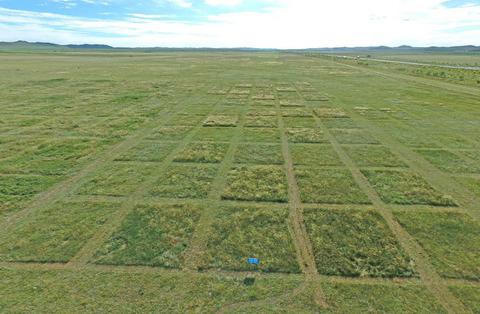Our official English website, www.x-mol.net, welcomes your
feedback! (Note: you will need to create a separate account there.)
Below‐ground‐mediated and phase‐dependent processes drive nitrogen‐evoked community changes in grasslands
Journal of Ecology ( IF 5.3 ) Pub Date : 2020-05-11 , DOI: 10.1111/1365-2745.13415 Qiuying Tian 1 , Liuyi Yang 1, 2 , Pengfei Ma 1, 2 , Huirong Zhou 1, 2 , Nana Liu 3 , Wenming Bai 1 , Hong Wang 4 , Lifei Ren 1 , Peng Lu 1 , Wenwu Han 1 , Peggy A. Schultz 5 , James D. Bever 5 , Fu‐Suo Zhang 6 , Hans Lambers 6, 7 , Wen‐Hao Zhang 1, 2
中文翻译:

地下介导和阶段依赖性过程推动了草原上氮素诱发的群落变化
更新日期:2020-05-11
Journal of Ecology ( IF 5.3 ) Pub Date : 2020-05-11 , DOI: 10.1111/1365-2745.13415 Qiuying Tian 1 , Liuyi Yang 1, 2 , Pengfei Ma 1, 2 , Huirong Zhou 1, 2 , Nana Liu 3 , Wenming Bai 1 , Hong Wang 4 , Lifei Ren 1 , Peng Lu 1 , Wenwu Han 1 , Peggy A. Schultz 5 , James D. Bever 5 , Fu‐Suo Zhang 6 , Hans Lambers 6, 7 , Wen‐Hao Zhang 1, 2
Affiliation

|
- Enhanced deposition of atmospheric nitrogen (N) leads to loss of plant diversity in grassland ecosystems. Numerous theories have provided potential explanations for the negative effects of N enrichment on plant diversity. However, the relative importance of each mechanism and the time‐scales of responses for the different functional groups remain unclear.
- We investigated the temporal responses of plant community in a temperate steppe to N enrichment by linking above‐ground to below‐ground processes using a series of field N‐addition and greenhouse experiments.
- The N enrichment‐induced declines in plant diversity of grasslands were phase‐based, functional group‐dependent and driven by three below‐ground processes. The rapid accumulation of
 by N addition inhibited photosynthetic rates of broad‐leaf non‐rhizomatous forbs, contributing to loss of these N‐sensitive species during early phase of N enrichment (≤3 years). The N‐induced changes in this phase were independent of soil pH as evidenced by results from application of lime to mitigate N‐evoked soil acidification. With progression of N addition, manganese (Mn) toxicity to narrow‐leaf non‐rhizomatous forbs due to soil acidification‐induced Mn2+ mobilization in soil accounted for their loss in the second phase of N enrichment (~4–9 years). When N addition proceeded longer than ~10 years, N enrichment stimulated below‐ground meristem differentiation and rhizome growth of the rhizomatous species, leading to the dominance by rhizomatous sedges/grasses in the community at the later phase of N enrichment.
by N addition inhibited photosynthetic rates of broad‐leaf non‐rhizomatous forbs, contributing to loss of these N‐sensitive species during early phase of N enrichment (≤3 years). The N‐induced changes in this phase were independent of soil pH as evidenced by results from application of lime to mitigate N‐evoked soil acidification. With progression of N addition, manganese (Mn) toxicity to narrow‐leaf non‐rhizomatous forbs due to soil acidification‐induced Mn2+ mobilization in soil accounted for their loss in the second phase of N enrichment (~4–9 years). When N addition proceeded longer than ~10 years, N enrichment stimulated below‐ground meristem differentiation and rhizome growth of the rhizomatous species, leading to the dominance by rhizomatous sedges/grasses in the community at the later phase of N enrichment. - Synthesis. The hierarchical mechanisms not only provide a comprehensive explanation for the N enrichment‐induced diversity decline in grasslands, but can also facilitate us to understand the differential sensitivities of ecosystems to chronic N enrichment, and predict future ecosystem dynamics.
中文翻译:

地下介导和阶段依赖性过程推动了草原上氮素诱发的群落变化
- 大气氮(N)沉积的增加导致草地生态系统中植物多样性的丧失。许多理论为氮富集对植物多样性的负面影响提供了潜在的解释。但是,每种机制的相对重要性以及针对不同功能组的响应时间尺度仍然不清楚。
- 我们通过一系列田间增氮和温室试验,通过将地上过程与地下过程联系起来,研究了温带草原植物群落对氮素富集的时间响应。
- N富集引起的草原植物多样性的下降是基于阶段的,取决于功能组的,并且是由三个地下过程驱动的。
 氮的快速积累抑制了阔叶非根茎类植物的光合速率,在富氮初期(≤3年)导致这些对氮敏感的物种丧失。N引起的这一阶段的变化与土壤pH无关,这通过石灰缓解N引起的土壤酸化的结果证明。随着氮的添加,由于土壤酸化诱导的Mn 2+,锰(Mn)对窄叶非根茎类前菜的毒性土壤中的动员是其在氮富集第二阶段(约4-9年)中损失的原因。当添加氮的时间超过〜10年时,氮的富集会刺激地下分生组织的分化和根茎的生长,从而在氮富集的后期导致社区中的根茎莎草/草占主导地位。
氮的快速积累抑制了阔叶非根茎类植物的光合速率,在富氮初期(≤3年)导致这些对氮敏感的物种丧失。N引起的这一阶段的变化与土壤pH无关,这通过石灰缓解N引起的土壤酸化的结果证明。随着氮的添加,由于土壤酸化诱导的Mn 2+,锰(Mn)对窄叶非根茎类前菜的毒性土壤中的动员是其在氮富集第二阶段(约4-9年)中损失的原因。当添加氮的时间超过〜10年时,氮的富集会刺激地下分生组织的分化和根茎的生长,从而在氮富集的后期导致社区中的根茎莎草/草占主导地位。 - 综合。分层机制不仅可以为草地上氮素富集引起的多样性下降提供全面的解释,而且还可以帮助我们了解生态系统对慢性氮素富集的不同敏感性,并预测未来的生态系统动态。











































 京公网安备 11010802027423号
京公网安备 11010802027423号